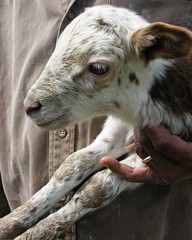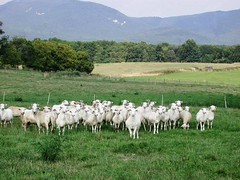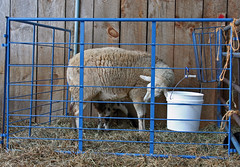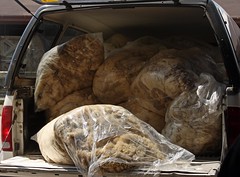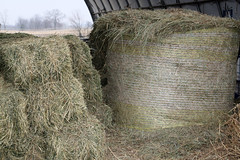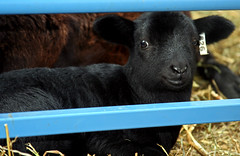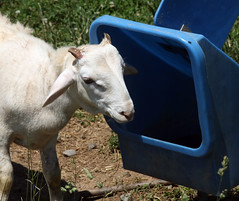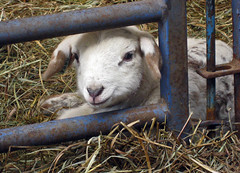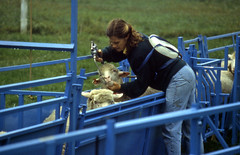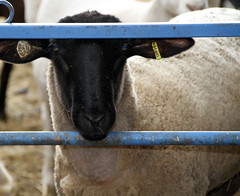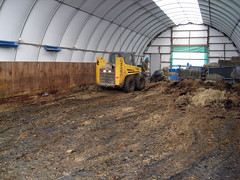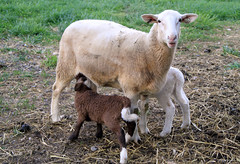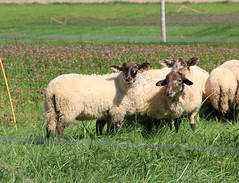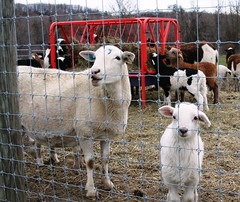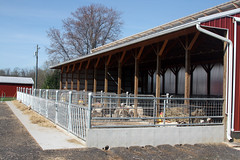- Sheep 201 Index
- Other web sites
Enterprise budgetingOne of the best ways to estimate the profitability of an agricultural enterprise is to do an enterprise budget. If an enterprise is not profitable on paper, it is not likely to be profitable in practice.
An enterprise budget is a list of income and expenses, based on a set of assumptions. Enterprise budgets estimate profitability for agricultural enterprises. They are useful for performing breakeven analyses and can be used to select the mix of enterprises on a farm.
Below is a sample budget for a sheep enterprise with 100 ewes lambing annually. While the budget uses realistic figures, for an enterprise budget to be useful, it is important to use your own figures. This budget is meant only to serve as an example.
FLOCK COMPOSITION PRODUCTION ASSUMPTIONS Number of ewes Pecent lamb crop raised Number of rams Ewe replacement rate Adult death loss Ram replacement rate INCOME Market lambs Cull ewes Cull rams Shorn wool Wool LDP Unshorn lamb pymt Government payments Other income TOTAL INCOME OPERATING COSTS Feed costs Hay Grain Salt and minerals Feed for lambs Pasture maintenance Health program Deworming (adults) Deworming (lambs) Vaccinations (adults) Vaccinations (lambs) Other vet costs Other costs Shearing Ram replacement Bedding Supplies Hauling Livestock protection Clean barn Other expense Interest TOTAL COSTS Return to land, labor, and capital Cost per lb. of liveweight Cost per lb. of carcass weight You can download this budget as an Excel file and use your own figures and assumptions to estimate the profitability of your sheep enterprise.
Budget explantation
Before you construct a budget for an agricultural enterprise, you first have to make some assumptions. In this sample budget, flock composition is the number of breeding ewes and rams in the flock. Lambing percentage is the percentage (or number ) of lambs that you will market or retain from each ewe in the flock. This includes ewes that fail to get pregnant and/or raise a lamb. It also takes into account any death losses that occur before marketing or retention.
Lambing percentage is one of the most important factors affecting profitability of a sheep enterprise. The figure you use will have a very large effect on profitability. You should experiment with different levels of productivity to determine what level of production is necessary to achieve a profit.
Ewe replacement rate is the percentage of ewes that are replaced in the flock each year. You need to keep enough ewe lambs to replace the ewes that die, as well as the ones that you cull. A replacement rate of 15 to 20 percent is common. You can make more rapid genetic improvement if you replace ewes at an accelerated rate. Seedstock producers tend to replace females at a faster rate than commercial breeders. There tends to be a higher rate of replacement in intensively managed flocks, including dairy flocks.In some operations, it is common to purchase replacement females. In this case, the ewe replacement rate would be zero and the cost of replacement ewes would be a fixed cost (depreciation) of doing business. Fixed costs are not included in this simple budget.
The ram replacement rate reflects how many years a ram is used. A 33 percent replacement rate means that the ram is used for three years before being culled or sold. In this budget, it is assumed that breeding rams are purchased. Otherwise, the flock is closed to outside animals.
Income
The income from a sheep enterprise includes the proceeds from the sale of market lambs, breeding stock, cull ewes and rams, and wool. It may also include government payments.
Lamb prices will vary by year, season, type and quality of lamb, and marketing method. Lighter weight lambs usually bring more per pound than heavy weight lambs, but bring less total dollars. Male lambs may bring more than ewe lambs. Since marketing costs are not included anywhere else in the budget, the market price in the budget should include any selling fees, as well as the American lamb check-off.
Prices for cull ewes and cull rams will also vary. Extremely thin or fat sheep are usually discounted in the marketplace. If your "culls" are still healthy, productive animals, you can try selling them for breeding to increase their value. Another alternative is to have cull animals slaughtered and have their meat made into sausage or snack sticks. The stronger flavor of mutton will be masked by the seasoning. On the other hand, some consumers favor the richer flavor of mutton.
Wool prices vary by year, marketing method, and type of wool. Fine wool that is skirted brings the most money in the commodity market. Producers who direct market their wool to hand spinners and weavers may receive substantially more for their fleeces.
Depending upon wool prices, wool income can be increased by participating in the government wool LDP program, which provides payments for both shorn wool and unshorn lamb wool. LDPs are not paid if wool prices exceed the support prices. The support price for wool is 40 cents per pound for ungraded wool and $1 per pound for graded wool. Wool income will be zero for hair sheep producers or wool producers who throw their wool away or give it to the shearer.
Expenses
Many producers believe that the only way to make money raising sheep or to make more money is to increase income. Lowering production costs is probably a more realistic way to increase the net income from a sheep enterprise. This can be done by lowering expenses and/or increasing productivity.
Feed costs
Feed costs are usually the largest expense associated with raising sheep and similar livestock. They include hay, grain, mineral supplements, lamb feed, and pasture costs. Though it varies by climate and production system, it usually takes from 1/4 to 1/3 of a ton (4 to 5 lbs. of hay for 120 to 150 days) to feed a ewe over the winter. There can be a lot of waste associated with feeding hay, especially round bales, so these losses should be factored into the budget.
The figure for hay will be lower if the winter feeder period is shortened due to a longer growing season or an extended grazing season. The figure will be higher when the winter feeding period is longer due to a shortage of pasture or a shorter growing season. Some producers may feed year-round. The price of hay will vary significantly by geographic location, year, and type of hay. It is important to buy hay by weight (ton) so you know the cost of it.
The amount of grain fed depends upon the production system and the productivity of the ewes. This budget assumes that 15 lbs. of grain is fed to a ewe during the last month of gestation (an average of 0.5 lbs. per day). It assumes that grain is fed for the first 60 days of lactation at a rate of one pound per offspring. The cost of grain fed to ewes can vary signficantly,
A complete sheep feed bought at a feed store can be very expensive. Grain costs can be reduced significantly if farm grains are used and simple rations are mixed on the farm. If a high quality legume hay (e.g. alfalfa) is fed during lacation, whole corn or barley can be fed, as opposed to a more expensive mixed ration.
It is more difficult to estimate salt and mineral consumption by sheep. Estimates are given on the label, but sometimes sheep will eat more or less. There are considerable differences in mineral costs. Mineral costs can be reduced by feeding a trace mineral salt mix instead of a complete mineral. There is no need to provide supplemental minerals if the sheep are consuming an otherwise balanced ration.
Some lambs may never see a bite of grain, whereas others will be creep-fed and finished on concentrate rations. This budget assumes that lambs are creep fed, then pastured and fed a pound of grain per day for 60 days post-weaning.
Pasture costs would include establishment, renovation,and maintenance of pasture. Maintenance costs would include lime and fertilizer costs. They might also include spraying or mowing for weed control. Fence repairs can be included with pasture costs, though repairs are generally considered a fixed cost.
Health
The next section of the budget is for health (veterinary) costs. Detail is provided on deworming and vaccinations. Deworming should be done on an as-needed basis only, so it is hard to estimate yearly costs. For the purpose of the budget, it is assumed that each adult sheep is dewormed an average of once per year and that each lamb is dewormed an average of two times. Lambs are vaccinated twice for CD-T. Ewes and rams are boostered annually. The figure for additional vet costs would include other medicines, such as antibiotics and mineral and vitamin injections. The figure does not include veterinary services. It is assumed that the shepherd his or her own vet work.Supplies
Needles and syringes would be included in the figure for supplies. Other supplies might include ear tags, rubber rings (for docking and castrating), and nipples (for bottle feeding).
Other costs
If traditional wooled sheep are being raised, there may be an annual cost of shearing. Some sheep (e.g. long wool breeds) are sheared twice per year. This budget item will be zero if hair sheep are raised or the shepherd does his or her own shearing.
The budget includes a ram cost, as a ram is replaced every three years. The rule of thumb is that a "good" ram is worth the value of five market lambs. A good ram would be one with performance records, especially EBVs (estimated breeding values). If replacement ewes are purchased instead of raised, their cost will need to be added to the budget. The cost of a replacement ewe varies by age, breed, health status, and registration.
Unless the sheep are kept outside year-round (without housing), most enterprises will incur a cost for bedding. It is difficult to estimate this cost, as bedding costs vary and different types of bedding can be used: straw, hay, shavings, newspaper, etc. The best figure is one obtained from actual costs in previous years of production.
There is usually a cost associated with hauling animals to market. This cost should be included in the enterprise budget. A higher cost should be put if someone else will be paid to transport lambs to market. If lambs are picked up at the farm, there will be no cost for this item. The cost of hauling can also be built into the selling price of the lambs.
If the farm uses guardian dogs (or other livestock guardians) for predator control, the cost of maintaining these animals should be included in the budget. This figure would include the cost of food and health care (shots, heartworm medicine, etc.)
The sheep enterprise may incur various other expenses that should be included in the budget. Producers that don't have equipment may need to pay someone to clean their barn and/or mow their pastures.
The last item in the budget is interest on operating money. It is the cost of using money. If you didn't raise sheep and invested the money instead, what could you earn? Sheep raising should be competitive with alternative uses of the money. The money is charged for six months at a current interest rate.
Fixed costs
Fixed costs are often referred to as the "DIRTI-5": depreciation, taxes, interest (on investment), land charges, and insurance. Sometimes a management fee is included as a fixed cost. These costs are considered to be “fixed” because they generally remain the same within a production period and do not vary with the level of output. Indirect, noncash, and overhead costs are other terms used to describe fixed costs. When there are more than one enterprise on the farm, it is more difficult to assign fixed costs to specific enterprises. Depreciation is one of the most important fixed costs on a farm. This is where the cost of buying breeding stock and equipment is accounted for.
The bottom line
In this budget, the difference between income and expenses represents the return to land, labor, and capital. Ideally, you want to earn a profit above total costs every year.
Spreadsheet budgets
Several land grant universities have developed budgets for sheep production.
Virginia Tech (2011)
Purdue University (2016)
Kansas State University (2018)
Cornell University (2015)
University of Idaho (2014)The University of Maryland has developed a more detailed budget to evaluate the profit potential of sheep. Scroll down to see spreadsheet options.
The American Sheep Industry Association has determined baseline estimates for the cost of producing lambs at different geographic locations. Click HERE to learn more.
Enterprise budgeting
<== SHEEP 201 INDEX
Copyright© 2021. Sheep 101 and 201.

